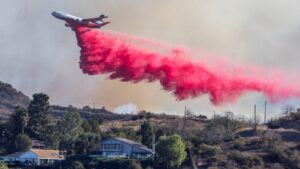Extreme Investor Network: The Rising Demand for Aerial Firefighting Solutions
As 2025 unfolded, wildfires devastated the Los Angeles area, engulfing neighborhoods and prompting swift action from aerial firefighting companies that were supposed to be on their winter break. The alarming rise of these infernos, like the destructive Palisades and Eaton fires, has ignited not only urgent safety concerns but also a significant business opportunity for those in the aerial firefighting sector.
Aerial Firefighting: An Essential Industry
The California Department of Forestry and Fire Protection (Cal Fire) boasts the largest civil fleet of firefighting aircraft in the world, with over 60 fixed-wing and rotor-wing aircraft at their disposal. However, they are just one piece of a larger puzzle; private operators like 10 Tanker Air Carrier are stepping up to meet an industry demand that has grown year-round.
Joel Kerley, CEO of 10 Tanker, reflected on the pressing need for aerial support during these recent fires. "I was lucky to have two aircraft available to help fight the flames," he noted. His company operates a fleet of four converted DC-10 aircraft, known as Very Large Air Tankers (VLATs), which are uniquely equipped for intense firefighting operations.
The Changing Landscape of Wildfires
Wildfire season has traditionally spanned from April to November in the U.S., but climate change has blurred these seasonal lines. The increasing severity and unpredictability of wildfires indicate that the "off-season" is rapidly disappearing. The United Nations Environment Program warns that wildfires are expected to become more prevalent and devastating in the 21st century. Recent data from the U.S. Environmental Protection Agency corroborates this, showing a marked increase in the area destroyed by wildfires over the past two decades.
Kerley’s insight into the limitations of available equipment underscores an urgent call to action: "There’s not enough air tankers to go around." As the number and intensity of wildfires increase, so too does the need for innovative solutions in firefighting.
Fleet Expansion and Maintenance Challenges
The off-season is typically reserved for routine maintenance of firefighting aircraft. However, the unanticipated onset of wildfires pushed companies like 10 Tanker into a scramble, drawing upon already stressed resources. Both Kerley and Sam Davis, CEO of Bridger Aerospace, which operates innovative water-scooping aircraft, indicated that while they were willing to respond, aviation maintenance kept some aircraft grounded initially.
Interestingly, Bridger Aerospace recently reported record revenue, attributing their success to soaring demand for firefighting aircraft as dry weather lingered in the Western U.S. For investors, this spells opportunity. Bridger raised its revenue estimate for the year significantly, projecting between $70 million to $95 million – a telling sign of how adaptability in operations can yield dividends in the face of crisis.
Technological Advancements in Aerial Firefighting
Aircraft designed for firefighting are undergoing significant technological transformations. For instance, Bridger’s Super Scoopers, which refill with water while flying, substantially boost efficiency by allowing for multiple drops in one mission. However, acquiring and modifying aircraft for these tasks is not quick or cheap. Kevin McCullough, president of Aero Air, mentioned that converting a jet for firefighting can take as long as a year and a half, involving extensive modifications.
As demand escalates, aircraft manufacturers are responding as well. De Havilland Aircraft in Canada is developing a new generation of water scooping aircraft—the DHC-515—expected to enter service by 2028. These innovations will incorporate advanced features for improved efficiency and durability, reflecting a growing trend of proactive adaptation to fire suppression needs.
Conclusion: Investing in an Evolving Market
The recent wildfires across Los Angeles have starkly illustrated the pressing need for enhanced capabilities in aerial firefighting. As companies grapple with maintaining and expanding their fleets to meet year-round demands, investors have a unique opportunity to engage in this transformative sector. The correlation between climate change, technological advancement, and escalating demand positions the aerial firefighting industry as not just essential but also a promising avenue for investment.
At Extreme Investor Network, we continue to monitor these trends to help our readers make informed decisions about where to allocate their resources in this dynamic landscape. The call for innovative, effective solutions in firefighting is not just a matter of safety—it’s an open invitation to participate in shaping the future of an essential industry. Stay tuned for more insights and updates as we track this evolving market.

